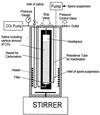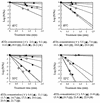Accelerated death kinetics of Aspergillus niger spores under high-pressure carbonation
- PMID: 12147527
- PMCID: PMC124054
- DOI: 10.1128/AEM.68.8.4162-4167.2002
Accelerated death kinetics of Aspergillus niger spores under high-pressure carbonation
Abstract
The death kinetics of Aspergillus niger spores under high-pressure carbonation were investigated with respect to the concentration of dissolved CO2 (dCO2) and treatment temperature. All of the inactivation followed first-order death kinetics. The D value (decimal reduction time, or the time required for a 1-log-cycle reduction in the microbial population) in the saline carbonated at 10 MPa was 0.16 min at 52 degrees C. The log D values were linearly related to the treatment temperature and the concentration of dCO2, but a significant interaction was observed between them.
Figures







Similar articles
-
Inactivation of Aspergillus niger in mango nectar by high-pressure homogenization combined with heat shock.J Food Sci. 2009 Nov-Dec;74(9):M509-14. doi: 10.1111/j.1750-3841.2009.01370.x. J Food Sci. 2009. PMID: 20492122
-
The influence of dissolved CO(2) concentration on the death kinetics of Saccharomyces cerevisiae.J Appl Microbiol. 2001 Aug;91(2):306-11. doi: 10.1046/j.1365-2672.2001.01386.x. J Appl Microbiol. 2001. PMID: 11473595
-
Microbial and Sensory Effects of Combined High Hydrostatic Pressure and Dense Phase Carbon Dioxide Process on Feijoa Puree.J Food Sci. 2015 Nov;80(11):E2478-85. doi: 10.1111/1750-3841.13083. Epub 2015 Oct 7. J Food Sci. 2015. PMID: 26444875
-
High pressure carbon dioxide inactivation of microorganisms in foods: the past, the present and the future.Int J Food Microbiol. 2007 Jun 10;117(1):1-28. doi: 10.1016/j.ijfoodmicro.2007.02.018. Epub 2007 Mar 12. Int J Food Microbiol. 2007. PMID: 17475355 Review.
-
Activation of ascospores by novel food preservation techniques.Adv Exp Med Biol. 2006;571:247-60. doi: 10.1007/0-387-28391-9_17. Adv Exp Med Biol. 2006. PMID: 16408607 Review. No abstract available.
Cited by
-
Combination of supercritical CO2 and high-power ultrasound for the inactivation of fungal and bacterial spores in lipid emulsions.Ultrason Sonochem. 2021 Aug;76:105636. doi: 10.1016/j.ultsonch.2021.105636. Epub 2021 Jun 19. Ultrason Sonochem. 2021. PMID: 34192660 Free PMC article.
References
-
- Ballestra, P., A. A. Da Silva, and J. L. Cuq. 1996. Inactivation of Escherichia coli by carbon dioxide under pressure. J. Food Sci. 61:829-836.
-
- Becker, Z. E. 1933. A comparison between the action of carbonic acid and other acids upon the living cell. Protoplasma 25:161-175.
-
- Dixon, N. M., and D. B. Kell. 1989. The inhibition by CO2 of the growth and metabolism of micro-organisms. J. Appl. Bacteriol. 67:109-136. - PubMed
Publication types
MeSH terms
Substances
LinkOut - more resources
Full Text Sources

